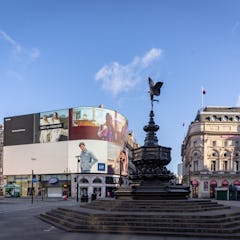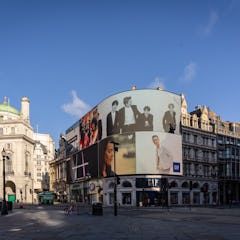History
Tracing its origins back to 1819, Piccadilly Circus was created by John Nash as a link between Regent Street and the shopping district of Piccadilly. The term “circus” refers to the roundabout around which the traffic circulates. The road Piccadilly has been around since the 1700s and gets its name from a type of collar called “piccadill”.
Key Features
The square is most recognisable from the extensive advertising displays, similar to the Times Square in New York, which have been an essential part of the square since the early 20th century. The curve of lit-up screens showcases adverts 24/7, making it one of London’s most photographed spots. The displays were combined into one huge high-resolution display in 2017.
In the centre of Piccadilly Circus stands the Shaftesbury Memorial Fountain, an iconic Anteros statue. It was erected in 1893 in honour of Lord Shaftesbury, a philanthropist known for his charitable works. One of the roads from Piccadilly Circus is Shaftesbury Avenue, known for its many theatres.
Surrounding Attractions
The roundabout is surrounded by gorgeous buildings and connected to Regent’s Street, Leicester Square, and Piccadilly. Regent Street is famous for its curved layout and flagship stores and is a shopping haven for those who love luxury and high-street brands.
Leicester Square is just a short walk away and is the epicentre of London's entertainment district, home to cinemas, theatres, and nightclubs. This is where movie premiers with the cast are held.
As the whole of West End, Soho is known for its diverse and vibrant nightlife, dining, drinking, and live entertainment.
Why Visit Piccadilly Circus?
Piccadilly Circus is more than just a busy junction; it symbolises London's dynamic and rich history. Whether you're capturing the ever-changing ads, admiring the architecture, or using it as a starting point to explore neighbouring areas, there's no denying its charm. It is one of the busiest places in London, so be prepared for crowds.








